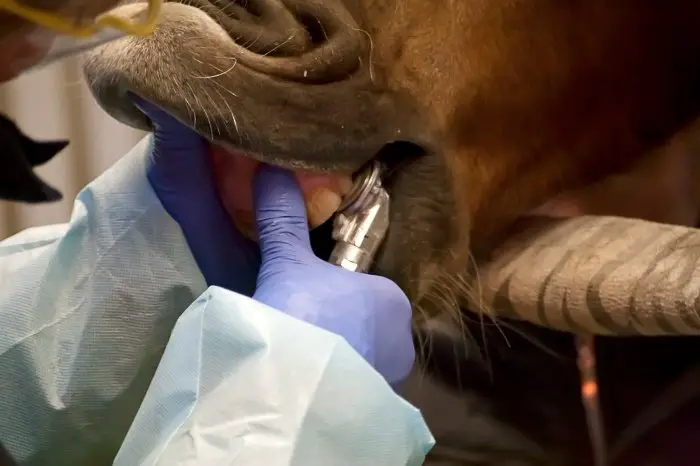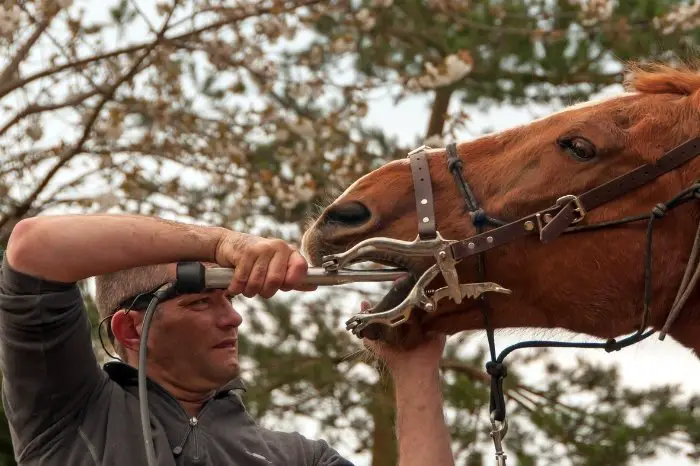Last Updated on January 12, 2023
The horse world is full of strange terminology, and you may hear other horse owners talking about having their horse’s teeth floated. But what does it mean to float a horse’s teeth?
Floating a horse’s teeth is part of the routine dental care of the horse. Every horse should have their teeth regularly checked, and they may need floating to correct any problems.
Let’s take a look at the world of horse dental care and find out all about floating!
What Is Floating A Horse’s Teeth?
All horses and ponies need regular dental checks by a qualified professional. If any abnormalities are detected on the dental check, a device will be used to smooth sharp edges and level the surface of the tooth. This process is called floating.

Why Do Horses Need Their Teeth Floating?
Horses are herbivores, and their diet is made up almost entirely of tough roughage such as hay and grass. This food is hard to chew and will wear the grinding surface of the teeth down over time. To compensate for this, the horse’s teeth will continue to grow or erupt throughout the lifetime of the horse.
As the teeth grow and the horse chews, the teeth can start to wear down unevenly. This can cause problems such as:
- Hooks – Sharp protrusions that develop on teeth
- Ramps – A ‘ski slope’ appearance of the tooth surface
- Step mouth – When one tooth grows too long, normally because the opposite grinding tooth is missing
- Shear mouth – Over-exaggerated angle of the grinding surface
- Wave mouth – A series of ascending and declining grinding surfaces
Floating the horse’s teeth can help to correct many of these problems. This will mean the horse can continue to eat normally. If these dental problems are not treated, they can become very painful, and the horse may not be able to eat.
Read more about How Do Wild Horses Float Their Teeth?
What Happens If A Horse’s Teeth Are Not Floated?
If a horse’s teeth are not floated, then small abnormalities will gradually become worse and cause health problems for the horse. Small hooks will turn into large painful spurs, which can rub the mouth and cause ulcers. This will stop the horse from eating and may cause them to drool.
Ramps and overgrowths which are not floated will continue to get bigger and can hinder the normal chewing action of the horse. Horses chew their food in a circular motion, and any abnormalities will prevent the horse from doing this. This means that food will not be chewed thoroughly and the horse cannot digest it properly.
Signs that a horse has dental problems are easy to spot. They may not chew food properly and can drop balls of chewed hay or grass on the floor. Sometimes balls of half-chewed food will get stuck around the teeth or inside the cheeks.
Other signs of dental abnormalities include weight loss, reduced appetite, and behavioral problems when ridden.
How Are Horse’s Teeth Floated?
The easiest way to describe floating a horse’s teeth is to think of it as a file or rasp. The sharp edges or abnormal growths are removed or corrected using a rough abrasive surface. Exactly the same as filing your nails, but on a much larger scale!
The tools used to do this are called dental floats – metal files on the end of a long handle. Dental floats come in a wide range of shapes, sizes and textures, to enable the dental professional to reach and treat all areas of the mouth.
Equine Horse Dental Teeth Floats Rasps Straight + Angled Adjustable Veterinary
Dental floats come in two types – manual and powered. Manual dental floats are on a simple straight metal handle and are moved over the tooth by hand to rasp away the overgrowth. Powered dental floats have a rotating or oscillating rasp, which is held over the tooth to correct the abnormality.
To access the horse’s teeth safely, the dental professional will normally use a gag to hold the mouth open. It is very common to give horses a sedative to keep them calm during this procedure. This is because it can be very hard to access the back of the horse’s mouth, and they may start to panic when the teeth are being floated.
Who Can Float A Horse’s Teeth?
It is vital that only a qualified professional is allowed to float a horse’s teeth. If this procedure is done by someone without the proper training, they may cause irreparable damage to the horse’s teeth. Problems can also be caused if any small abnormalities are not noticed. As a result, these will become worse over time and require more treatment.
In most countries, equine veterinary surgeons will carry out dental floating. This can be very useful if your horse needs sedating, as they will do this for you as well! You may need to take your horse to the veterinary clinic to have his teeth floated, or they may visit your yard to do it.

If your veterinary clinic does not do dental floating, you will need to find an equine dental technician. Look for one with a qualification which is recognized in your country – your veterinary surgeon may be able to recommend someone to you. Check that your equine dental technician is registered and insured.
How Often Do Horse’s Teeth Need Floating?
Your horse’s teeth should be checked every year by a dental professional. If they have had dental problems in the past, they may recommend that the check takes place every 6 months. Your horse will not necessarily need his teeth floating every time they are checked; however, regular checks are important to prevent any serious problems from developing.
Summary
In conclusion, good dental health is vital to a horse’s well-being. Therefore, regular dental checks and floating are essential to keep the teeth in good condition. Floating is the process where sharp points and overgrowths are rasped using a dental float. Horse’s teeth should only be floated by a qualified professional, and the horse may need to be sedated for this procedure.
We’d love to hear about your experiences – perhaps your horse enjoys having his teeth floated? Or maybe you have questions about how horse’s teeth are floated? Add a comment below this post and we’ll get back to you!
Does floating a horse’s teeth hurt?
No, floating teeth is a simple procedure and your horse will not hurt during floating. The nerve endings in your horse’s tooth are much deeper than in humans, so horses won’t feel pain when it’s being worked on their teeth.
It’s a good idea to get a vet to perform the procedure as it is not something you can do yourself. The first time you perform a float is probably the most important because it’s what will set your horse up for future treatments. It’s always best to start with a young horse with sound teeth, because they tend to have fewer problems that need to be addressed.
Why don t wild horses need their teeth floated?
Wild horses don’t need their teeth floated because they have a different diet than domestic horses. Wild horses eat grass, leaves, herbs, roots, berries, nuts, seeds, buds, and bark. Their diet includes more forage and minerals that help with the grinding down horse’s teeth without the help of man.
A diet of the domestic horses typically include more grains, which have a different impact on horse’s teeth than grass. This has been a problem because these grains can cause dental problems. This is why we use a tooth float to keep domestic horses’ teeth healthy.
Do farriers float teeth?
Farriers are not allowed to float teeth on horses nor to give sedation shots to horses. Even if a farrier knows how to float horse’s teeth, it is not a good idea to do it as it’s illegal in many states to practice veterinary medicine unless board certified. Floating teeth is a veterinary job and requires a veterinary degree.
The practice of floating teeth was originally developed by veterinarians. As early as 1879, the American Veterinary Medical Association adopted the practice as a standard of care.
Can I ride my horse after teeth floating?
If your horse was sedated, it’s important that you wait 24 hours before riding. Sedation is sometimes necessary for dental procedures but it can cause your horse to be drowsy, which can be dangerous when you’re in the saddle. If your horse was sedated, he will have to be monitored closely while recovering from anesthesia for possible side effects. The most common side effect is ataxia (a loss of balance) but this usually goes away when the sedative wears off.
However, if your horse experienced a routine float without sedation, you should be able to ride your horse immediately.
At what age do you start floating a horses teeth?
It’s a good idea to get your horse’s teeth floated, between two and two and a half years of age. Horses typically loose their first baby teeth around the age of two and a half years old. Therefore, it is important to have an oral exam performed at this time as well as yearly thereafter. This will ensure that your horse is healthy and free of disease in the mouth. Floating teeth helps maintain a horse’s oral health. It also helps to prevent future problems by keeping the horse’s teeth from becoming over-grown, or chipped.

Kate Chalmers is a qualified veterinary nurse who has specialized in horse care for the vast majority of her career. She has been around horses since she was a child, starting out riding ponies and helping out at the local stables before going on to college to study Horse Care & Management. She has backed and trained many horses during her lifetime and competed in various equestrian sports at different levels.
After Kate qualified as a veterinary nurse, she provided nursing care to the patients of a large equine veterinary hospital for many years. She then went on to teach horse care and veterinary nursing at one of the top colleges in the country. This has led to an in-depth knowledge of the care needs of horses and their various medical ailments, as well as a life-long passion for educating horse owners on how to provide the best possible care for their four-legged friends.
Kate Chalmers BSc (Hons) CVN, Dip AVN (Equine) Dip HE CVN EVN VN A1 PGCE

